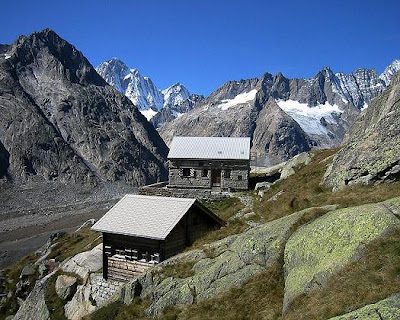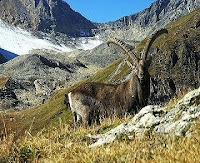Jungfrau Aletsch is located in south western Switzerland between the cantons of Berne and Valais. It is also called as Jungfrau Aletsch protected area and officially called as Swiss Alps Jungfrau-Aletsch. It is a mountainous region in the easternmost side of the Bernese Alps, containing the northern wall of Jungfrau and Eiger, and the largest glaciated area in western Eurasia, comprising the Aletsch Glacier. The Jungfrau-Aletsch protected area is the first World Natural Heritage site in the Alps, it was inscribed in 2001.
 The Jungfrau Aletsch protected area is located in the Swiss Alps between the Bernese Oberland and north-eastern Valais, about 25 km south of Interlaken and 20 km north of Brig. The site covers the whole Aar massif from the Oeschinensee in the west to the Giselle in the east, including the basins of the Aletsch, Fiescher, Aar and Grindelwald glaciers. The culminating point is the Finsteraarhorn which, with its 4,270 metres, is also the highest mountain in the Bernese Alps. 8 other summits above 4,000 metres are located in the area: Aletschhorn, Jungfrau, Monch, Schreckhorn, Gross Fiescherhorn, Hinter Fiescherhorn, Grunhorn and Lauteraarhorn.
The Jungfrau Aletsch protected area is located in the Swiss Alps between the Bernese Oberland and north-eastern Valais, about 25 km south of Interlaken and 20 km north of Brig. The site covers the whole Aar massif from the Oeschinensee in the west to the Giselle in the east, including the basins of the Aletsch, Fiescher, Aar and Grindelwald glaciers. The culminating point is the Finsteraarhorn which, with its 4,270 metres, is also the highest mountain in the Bernese Alps. 8 other summits above 4,000 metres are located in the area: Aletschhorn, Jungfrau, Monch, Schreckhorn, Gross Fiescherhorn, Hinter Fiescherhorn, Grunhorn and Lauteraarhorn.The summit ridge separating the cantons of Valais and Berne is the main watersheds of Europe. The principal valleys on the north side run due north below the precipitous 20 kilometer north wall of the Jungfrau, Monch and Eiger, thence to the Aar, a tributary of the Rhine which runs into the North Sea. The southern valleys drain into the southwest running valley of the Rhone which flows into the Mediterranean Sea. The climate of the region is strongly influenced by the height of the mountains. They form a barrier between the wet sub-oceanic climate of the north and the dryer climate of the south-facing Valais slopes. On the north side the rainfall exceeds 2,200 mm, most falling in summer, but on the south side it is only 1,000 mm, with more falling in winter. The Valais experiences a sub continental climate at low and medium altitudes and is markedly semi-arid. Mean annual temperatures range from -8.5°C at Jungfraujoch which is 3,500 m to 9.1°C at Brig.
The Jungfrau Aletsch site is almost untouched, except for trails and mountain huts. It is deeply glaciated. About half of the area is higher than 2,600m a few hundred metres lower than the limit between the glaciers accumulation and ablation zones. The total area covered by glacier is 35,000 ha, it constitutes the largest continuous area of ice in the Alps. The largest and longest glacier in the Alps, the Aletsch Glacier is 23 km long and has a maximum thickness of 900 metres at Konkordiaplatz. The protected site covers an area of 82,388 ha, comprising the 53,888 ha existing World Heritage Site plus extensions at both ends totaling 28,500 ha. 56% is within the Canton of Valais, 44% within the Canton of Berne.
Glaciers and barren rock constitute 80% of the area; 6% is forested, 5.2% is alpine meadow, and 8% is scrub. Altitude is the strongest factor influencing the distribution and diversity of the vegetation. Within the nominated area there are 1,800 species of vascular plants and 700 mosses. The growing period decreases with altitude, but there are 529 species of phanerogams and pteridophytes above the tree line. Broadleaf montane forest extends from 900m to 1,300m on north facing slopes. On south-facing slopes the same zone is approximately 200m higher. The subalpine zone lies between 1,300m to 2,000m, between the broadleaf and alpine zone. Characteristic species are the Swiss Pine or Pinus Cembra and the Norway Spruce or Picea abies on the north and south side respectively. An example of Pinus cembra forest is the Aletsch Forest above the Aletsch Glacier and near the tree line. It developed on the moraine of the glacier after its maximum extension in 1850. The zone directly above the tree line forms a girdle of moorland vegetation and Alpine grassland.


In Jungfrau Aletsch 1,250 species have been recorded on the site, including 271 vertebrates. In that 42 mammals, 99 birds, 8 reptiles, 4 amphibians, 7 fish, 97 molluscs plus 979 insects. As for the rest of the Alps, common species are the chamois, alpine ibex, red deer. Smaller mammals include the mountain hare, fox, ermine, marmot and the reintroduced lynx. Both the regions of the Bernese Oberland and Valais had been popular tourist destinations since the 19th century. The Jungfrau was first climbed in 1811 and the Finsteraarhorn in 1812. The first tourists came mostly in summer, but in the 1930s winter sports became also popular. On the north side visitors are only able to visit the site via the Jungfrau railway which leads to the Jungfraujoch. So the site is both exceptionally accessible to large nearby populations and rather inaccessible in itself.
The Jungfrau railway was built between 1870 and 1912, taking visitors from Kleine Scheidegg to Jungfraujoch, the saddle between the Monch and Jungfrau. On the south side the area of Riederalp Bettmeralp concentrates most of the visitors. Other inhabited regions on the margin are Kandersteg and the Lotschental and the Oberhasli. The network of foot-paths is well developed around the site but nonexistent inside, being inaccessible to walkers. The site can be accessed by experienced mountaineers and there is a series of 37 shelters and five mountain refuges with a total of 1,582 beds, managed by the Swiss Alpine Club. The Aletsch ecological centre in Riederalp run by Pro Natural functions as a visitor center.
Post Title
→Jungfrau Aletsch
Post URL
→http://guidice-galleries.blogspot.com/2010/06/jungfrau-aletsch.html
Visit guidice galleries for Daily Updated Wedding Dresses Collection








